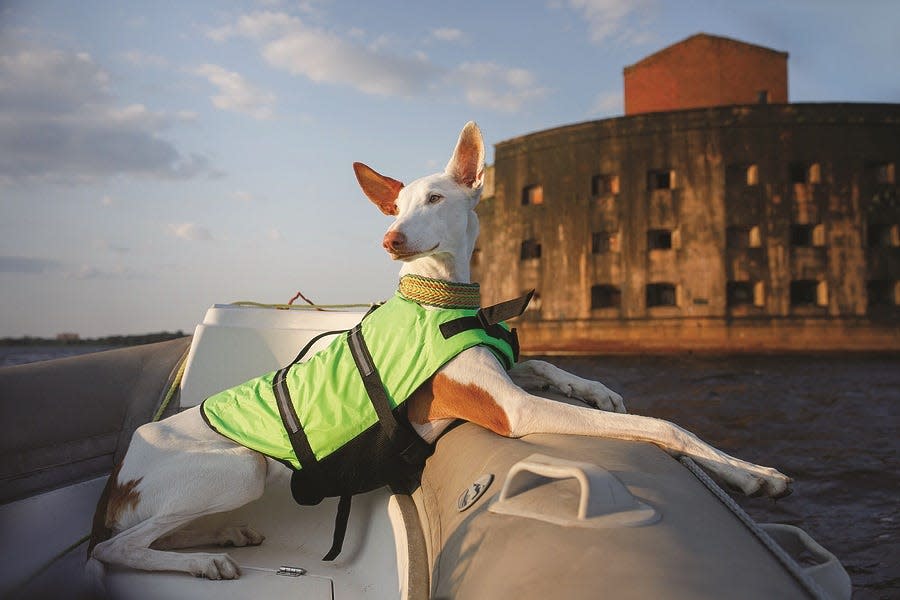Pets at Sea: Animals have been seagoing companions for millennia

Dogs and cats have accompanied sea voyagers since earliest times, as have other animals. Dogs helped to bring in nets, swim messages between boats and rescue people from water. Cats kept rats under control, thus protecting the food supply. Birds such as ravens were taken on Norse ships to serve as navigational aids because they were good at sensing land. Carrier pigeons delivered messages between ships or back to shore. We don’t think of horses as maritime animals, but they were portrayed on the Bayeux Tapestry in ships as part of William the Conqueror’s invasion force. In later centuries, horses patrolled shores and hauled boats into and out of water.
There are lots of animal-related museums around the world, but perhaps one of the more unusual is the Museum of Maritime Pets, located in Rockland, Maine. Dedicated to the innumerable dogs, cats, horses, birds and other animals who have made a living working with people on fishing boats, cargo ships and military vessels, it was founded in 2006 by historian, animal lover and former museum administrator Patricia Sullivan.
At first, it was a virtual museum, based in Annapolis, Maryland. The internet was young then, and the day after its website went live, Sullivan began receiving emails from people who had served in the military and had mascots on their ships, as well as from animal lovers in countries with strong maritime traditions, such as England, the Netherlands, Denmark, Norway and Sweden, all of whom were interested in the information about and images of animals at sea.
Sullivan rapidly connected with area animal, history and maritime organizations, including the Coast Guard Museum, the Navy Museum and the Library of Congress. Exhibits at Annapolis City Hall and talks and portable exhibits at libraries, country clubs and local events spread the word far and wide. The Canadian Navy’s Naval and Military Museum loaned an exhibit called “Creature Comforts,” about naval mascots. She set up working water dog demonstrations at a Chesapeake Bay, Virginia, beach.
“It took off really from the very beginning,” Sullivan says. “As social media came into its own, we became more connected.”
The goal was eventually to have an actual building, but costs were high and zoning laws strict in the Annapolis area. Sullivan began looking at other locations, and Rockland came to her attention. The museum now has a location on the water, part of a complex with other museums and near a park.
Permanent exhibits are made up of large panels that combine text and images, featuring such topics as maritime animals and lighthouse mascots. A small library contains books, maritime journals and other printed material available to researchers with advance notice. The museum shop sells books, T-shirts, toys, greeting cards and facsimiles of maritime animal art. Windows overlook the harbor.
Ambassadors at Sea are pets who live on boats or ships around the world. The two newest are Tea (pronounced Tay-ah) and Riki, cats adopted last fall in Rikitea on the French Polynesian island of Mangareva by the crew of the tall ship Picton Castle, headquartered in Lunenburg, Nova Scotia. When Sullivan heard about their adoption, she contacted the office and asked if they’d be interested in having their cats be the museum’s new ambassadors.
“They wrote back the next day and said they’d be honored,” Sullivan says. She was delighted since Maine and the Canadian province of Nova Scotia are neighbors.
Can your pet visit the museum with you? With prior permission, Sullivan says. The landlord doesn’t officially permit pets, but as long as Sullivan knows ahead of time, she can arrange for pets to visit. And a large waterfront park nearby is popular with locals and visitors for walks and off-leash play.
“Our museum has universal appeal for anybody who loves animals and the human-animal bond,” Sullivan says. “It’s for anybody who loves animals but is particularly interested in the historical bond of the working relationship with an animal."
— Kim Campbell Thornton
Do you have a pet question? Send it to askpetconnection@gmail.com or visit Facebook.com/DrMartyBecker. Pet Connection is produced by veterinarian Dr. Marty Becker, journalist Kim Campbell Thornton, and dog trainer/behavior consultant Mikkel Becker. ©2024 Andrews McMeel Syndication
This article originally appeared on South Bend Tribune: Pet Connection: Museum in Maine documents maritime pets

